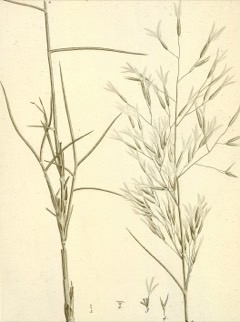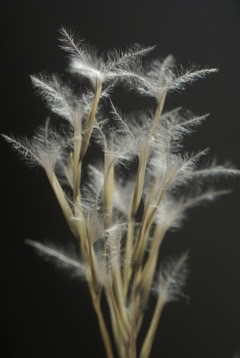 |
|
edibleplants.org |
 |
| Liliane ROUBAUDI - tela-botanica.org |
Translate this page:
Summary
Also known by the scientific name Aristida pungens. Stipagrostis pungens is a robust perennial 50 cm to 1 m). It is a long rhizomatous plant, recognizable by inflorescences composed of spikelets, in loose and ventilated panicles. Common throughout the Sahara, the drinn is perfectly adapted to sandy habitats. A traditional food plant in Africa, this grain has potential to improve nutrition, boost food security, foster rural development.
Physical Characteristics

 Stipagrostis pungens is an evergreen Perennial growing to 1 m (3ft 3in) by 0.2 m (0ft 8in) at a fast rate.
Stipagrostis pungens is an evergreen Perennial growing to 1 m (3ft 3in) by 0.2 m (0ft 8in) at a fast rate.
See above for USDA hardiness. It is hardy to UK zone 10.
Suitable for: light (sandy) and medium (loamy) soils, prefers well-drained soil and can grow in nutritionally poor soil. Suitable pH: mildly acid, neutral and basic (mildly alkaline) soils. It cannot grow in the shade. It prefers dry or moist soil and can tolerate drought. The plant can tolerate maritime exposure.
UK Hardiness Map
US Hardiness Map
Synonyms
Aristida pungens Desf. Arthratherum pungens (Desf.) P.Beauv.
Plant Habitats
Edible Uses
Edible Parts: Seed
Edible Uses:
Edible Portion: Seeds, Cereal. A traditional food plant in Africa, this grain has potential to improve nutrition, boost food security, foster rural development, and support sustainable landcare. It is used in kreb a grain mixture eaten in Chad. Carbon Farming Solutions - Staple Crop: balanced carb (The term staple crop typically refers to a food that is eaten routinely and accounts for a dominant part of people's diets in a particular region of the world) [1-1].
References More on Edible Uses
Medicinal Uses
Plants For A Future can not take any responsibility for any adverse effects from the use of plants. Always seek advice from a professional before using a plant medicinally.
A traditional medicinal annual plant growing in Tunisia.
References More on Medicinal Uses
The Bookshop: Edible Plant Books
Our Latest books on Perennial Plants For Food Forests and Permaculture Gardens in paperback or digital formats.

Edible Tropical Plants
Food Forest Plants for Hotter Conditions: 250+ Plants For Tropical Food Forests & Permaculture Gardens.
More

Edible Temperate Plants
Plants for Your Food Forest: 500 Plants for Temperate Food Forests & Permaculture Gardens.
More

More Books
PFAF have eight books available in paperback and digital formats. Browse the shop for more information.
Shop Now
Other Uses
Paper and Fibre mats: The chemical composition of S. pungens has showed that it contains quite high amount of extractives, lignin (around 12%) and polysaccharides (71%). The a-cellulose amounts are acceptable (44%).
Special Uses
Carbon Farming
References More on Other Uses
Cultivation details
Management: Coppice Management: Standard Staple Crop: Balanced carb Wild Staple Crop
Climate: tropical. Humidity: arid to semi-arid. Extremely drought-resistant, drinn grows in areas with as little as 70 mm of rainfall per year. Perennial, robust (50 cm to 1 m), long rhizomatous plant, recognizable by inflorescences composed of spikelets, in loose and ventilated panicles. Common throughout the Sahara, the drinn is perfectly adapted to sandy habitats, represented by deep sandy clusters (dunes, ergs). The steppe in drinn is an essential pasture for camels. Carbon Farming Solutions - Cultivation: wild staple. Management: standard, coppice (Describes the non-destructive management systems that are used in cultivation) [1-1]. .
Carbon Farming
-
Management: Coppice
Cut to the ground repeatedly - resprouting vigorously. Non-destructive management systems maintaining the soil organic carbon.
-
Management: Standard
Plants grow to their standard height. Harvest fruit, seeds, or other products. Non-Destructive management systems.
-
Staple Crop: Balanced carb
(0-15 percent protein, 0-15 percent oil, with at least one over 5 percent). The carbohydrates are from either starch or sugar. Annuals include maize, wheat, rice, and potato. Perennials include chestnuts, carob, perennial fruits, nuts, cereals, pseudocereals, woody pods, and acorns.
-
Wild Staple Crop
Some wild plants have strong historical or contemporary use. Although they are not cultivated crops, they may be wild-managed.
References Carbon Farming Information and Carbon Sequestration Information
Temperature Converter
Type a value in the Celsius field to convert the value to Fahrenheit:
Fahrenheit:
The PFAF Bookshop
Plants For A Future have a number of books available in paperback and digital form. Book titles include Edible Plants, Edible Perennials, Edible Trees,Edible Shrubs, Woodland Gardening, and Temperate Food Forest Plants. Our new book is Food Forest Plants For Hotter Conditions (Tropical and Sub-Tropical).
Shop Now
Plant Propagation
Seed. rhizomes.
Other Names
If available other names are mentioned here
Drinn, Eilig
Native Range
TEMPERATE ASIA: Saudi Arabia, Afghanistan, Egypt (Sinai), Iran AFRICA: Algeria, Egypt (?), Libya, Morocco, Tunisia, Sudan
Weed Potential
Right plant wrong place. We are currently updating this section.
Please note that a plant may be invasive in one area but may not in your area so it's worth checking.
Can be invasive in all it's growing areas.
Conservation Status
IUCN Red List of Threatened Plants Status : This taxon has not yet been assessed

Growth: S = slow M = medium F = fast. Soil: L = light (sandy) M = medium H = heavy (clay). pH: A = acid N = neutral B = basic (alkaline). Shade: F = full shade S = semi-shade N = no shade. Moisture: D = dry M = Moist We = wet Wa = water.
Now available:
Food Forest Plants for Mediterranean Conditions
350+ Perennial Plants For Mediterranean and Drier Food Forests and Permaculture Gardens.
[Paperback and eBook]
This is the third in Plants For A Future's series of plant guides for food forests tailored to
specific climate zones. Following volumes on temperate and tropical ecosystems, this book focuses
on species suited to Mediterranean conditions—regions with hot, dry summers and cool, wet winters,
often facing the added challenge of climate change.
Read More
Expert comment
Author
(Desf.) De Winter
Botanical References
Links / References
For a list of references used on this page please go here
Readers comment
| Add a comment |
|
If you have important information about this plant that may help other users please add a comment or link below. Only comments or links that are felt to be directly relevant to a plant will be included. If you think a comment/link or information contained on this page is inaccurate or misleading we would welcome your feedback at [email protected]. If you have questions about a plant please use the Forum on this website as we do not have the resources to answer questions ourselves.
* Please note: the comments by website users are not necessarily those held by PFAF and may give misleading or inaccurate information.
To leave a comment please Register or login here All comments need to be approved so will not appear immediately.
|
Subject : Stipagrostis pungens
|
|
|
|